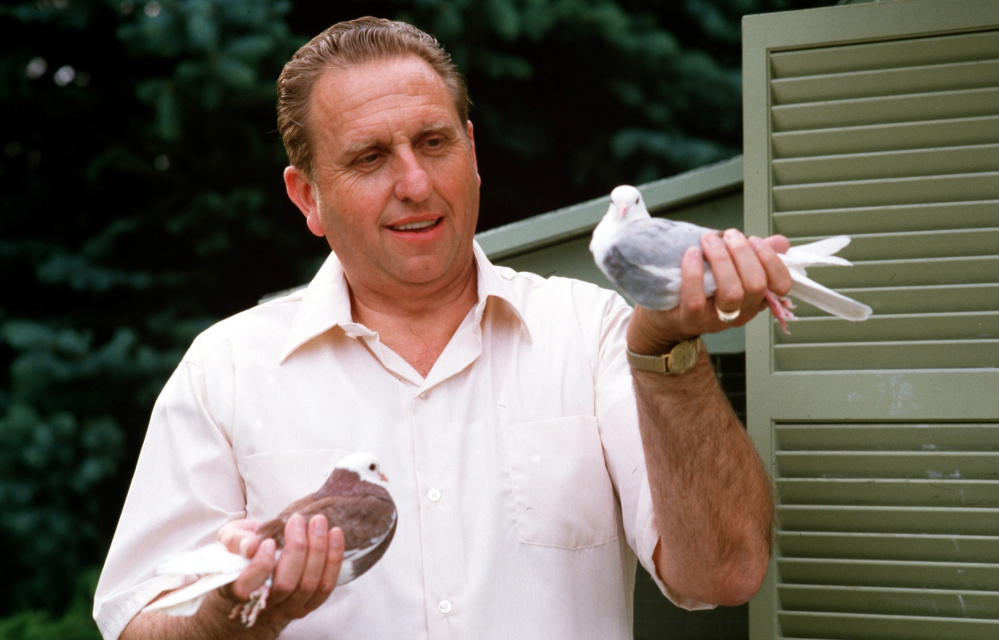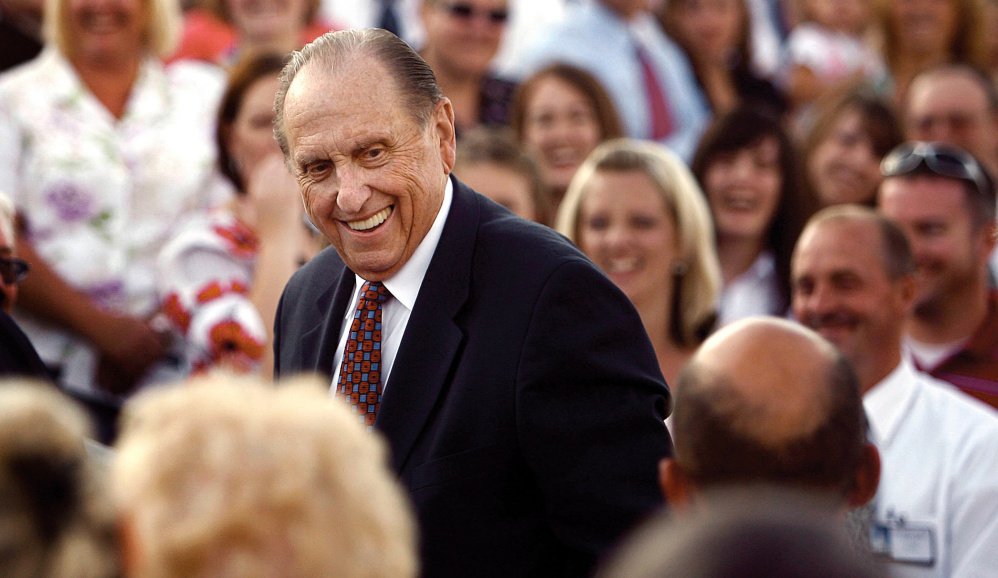Thomas S. Monson, who as president of the Church of Jesus Christ of Latter-day Saints for nearly a decade dramatically grew its missionary corps and upheld a long-standing opposition to same-sex marriage, despite the increasing acceptance of gay rights within and beyond the faith, died Jan. 2 at his home in Salt Lake City. He was 90.
The Mormon church announced the death in a statement but did not cite a specific cause. The church said in May that because of his age, Monson had stopped attending regular leadership meetings.
A former advertising and printing executive at the church-owned Deseret News in Utah, Monson spent half a century as a top Mormon leader. He helped expand the church’s reach through ecumenical charity work and through the construction of Mormon temples from Peru to what was then East Germany, where religious groups faced a frequently hostile communist government.
Monson assumed leadership of the church in 2008 after the death of President Gordon Hinckley, whom Monson had advised as first counselor – effectively the No. 2 position. While Monson was president in name, Mormons commonly referred to him as “the prophet,” the teacher who relayed messages from God to humanity.
Monson’s messages, spiritual or secular, were relatively few. Unlike his predecessor, an energetic speaker who jetted around the world well into his 90s, he maintained a low profile, calling few news conferences and rarely holding forth on Mormon doctrine.
Instead, he filled his public addresses with folksy parables that emphasized humanitarian service and care for others, an outlook that he said was rooted in his Depression-era upbringing in Salt Lake City.
“Time and time again those who were riding the rails came to our home. I think they had it marked,” he once told the Salt Lake Tribune, recalling the migrants who called upon his family asking if they could work for food. “My mother would say, ‘You come right in and sit down; wash your hands over there in the sink.’ And then she’d make a sandwich.”
Monson sought to spread a Mormon message of charity at a pivotal time in the faith’s history. “He helped usher in the church’s transformation from a Western, American institution to one that’s more international,” said Matthew Bowman, author of “The Mormon People: The Making of an American Faith.”
The group grew from some half-million members at the time of Monson’s birth to about 16 million at his death, with the majority located outside the United States. The growth was spurred in part by the church’s missionary program, in which young Mormon men are heavily encouraged to spend two years abroad spreading the faith or performing humanitarian work. Young women are encouraged to serve 18-month missions.
Monson presided over a significant expansion in the program, announcing in 2012 that the church would lower the minimum age for missionaries from 19 to 18 for men and from 21 to 19 for women. The church subsequently expanded leadership opportunities for female missionaries, although it continued to bar women from the priesthood. Since the changes were enacted, the program has grown from about 58,000 missionaries to more than 70,000, by church estimates.
Monson’s tenure coincided with what some observers christened a “Mormon moment” – a period in which Mormonism was frequently at the center of national news with the presidential campaigns of former Massachusetts Gov. Mitt Romney, R, who is Mormon. Amid its growing prominence, the church became embroiled in controversy during the national debate over same-sex marriage.
In one of his first major acts, Monson oversaw a church lobbying effort in support of California’s Proposition8, a 2008 ballot measure that outlawed same-sex marriage in the state. The church encouraged members to work with groups such as Protect Marriage, a principal backer of the ban; according to a New York Times report, as many as 90 percent of the organization’s early volunteers were Mormon, and about half of its $40 million funding was donated by Mormons.
Following a backlash, the church scaled back its efforts to oppose same-sex marriage rights, and threw its support behind legislation in Utah that combined anti-discrimination provisions for gay, lesbian, bisexual and transgender people with protections for religious groups that oppose homosexuality.
After a 2015 U.S. Supreme Court ruling that legalized same-sex marriage nationwide, however, the church adopted new rules stating that Mormons in same-sex marriages would be considered apostates, and that the children of same-sex couples could not be blessed or baptized until age 18. Baptism could only occur, according to the new policies, once the individual no longer lived in a same-sex household and had disavowed the practice of same-sex marriageor cohabitation.
Mormons who supported gay rights reacted with dismay and confusion, prompting Monson to issue a tweet: “I plead with you to avoid anything that will deprive you of your happiness here in mortality and eternal life in the world to come.”
One week later, more than 1,000 members gathered for a mass resignation ceremony in Salt Lake City.
Thomas Spencer Monson was born on Aug. 21, 1927. His father worked in the printing industry, and as a young man Tom developed an interest in pigeons, which he raised and trained throughout his life.
He served in the Navy at the close of World War II and received a bachelor’s degree in business management from the University of Utah in 1948, later graduating with a master’s degree in business administration from Brigham Young University.
Monson joined the Deseret News after college as an advertising executive and went on to serve as chairman of the church-controlled Deseret News Publishing Co. He became a member of the Quorum of the Twelve, the church’s second-highest governing body, in 1963 at 36, reportedly one of the youngest men to ever hold the position.
Monson also served on the board of the Boy Scouts of America and maintained its close link with the Mormon Church, which accounts for about 20 percent of the organization’s members. The church distanced itself from the Scouts in May, withdrawing its participation in some programs for teenagers. It said the separation was unrelated to the Scouts’ decision to admit gay and transgender Scouts and to allow gay men to serve as troop leaders.
Monson’s wife of 65 years, the former Frances Johnson, died in 2013. Survivors include three children, Thomas Monson, Ann Dibb and Clark Monson; eight grandchildren and 12 great-grandchildren.
Monson’s successor is expected to be announced after Monson’s funeral on Jan. 12, the church said. According to tradition, the longest-serving apostle is named president, making Russell Nelson, a 93-year-old former heart surgeon, Monson’s presumptive successor.
In part, the process is aimed to avoid internecine politicking among church leaders.
“I’ve always followed the philosophy, ‘Serve where you’re called, not where you’ve been or where you might be,’ ” Monson told the church’s news service in 2008, shortly after being named president. “I didn’t know but what President Hinckley would outlive me. Some die young, some die older.”
Send questions/comments to the editors.




Success. Please wait for the page to reload. If the page does not reload within 5 seconds, please refresh the page.
Enter your email and password to access comments.
Hi, to comment on stories you must . This profile is in addition to your subscription and website login.
Already have a commenting profile? .
Invalid username/password.
Please check your email to confirm and complete your registration.
Only subscribers are eligible to post comments. Please subscribe or login first for digital access. Here’s why.
Use the form below to reset your password. When you've submitted your account email, we will send an email with a reset code.